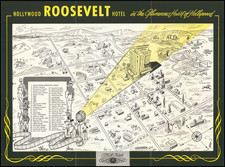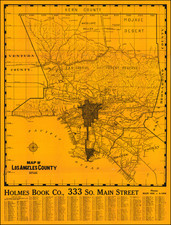The First Map of Beverly Hills -- With Hand-Annotations of Selling Prices.
The earliest known printed map of a portion of Beverly Hills and quite possibly the first ever promotional material printed in connection with the newly minted community.
The map covers the area north from Santa Monica Boulevard up Rodeo and Crescent Drives to Lexington Road and the homes above it.
Published 8 years before the incorporation of Beverly Hills as a city, the map is dated November 1906, and was issued less than 2 months after the first ever mention of Beverly Hills in a newspaper and shortly after the Percy H. Clark Company began promoting homesites for sale in their new development.
The prices of the lots are noted by hand, ranging from $1100 for the smallest lots on Crescent Drive and Cañon Drive (now Benedict Canyon Drive) to $7500 for the large lot at the top of Elden Way (now the Virginia Robinson Gardens, built by department store magnate Joseph Winchester Robinson in 1911).
The first ever mention of "Beverly Hills" appeared on September 2, 1906 when the Los Angeles Times reported:
Percy H. Clark Company are managing the development of the foothill portion of the Hammel & Denker ranch for the Rodeo Land and Water Company (the Canfield-Huntington-Kerckhoff syndicate), to be known as Beverly Hills. No expense is being spared to make this a fine suburban district. . . . The property has been laid out on beautiful curved lines.
The marketing of Beverly Hills as a luxury subdivision was begun by Percy H. Clark Co. in late October of 1906, with an onslaught of articles and advertisements appearing in the Los Angeles newspapers in November of that year (the same month as the publication of this map).
The 1913 Western edition of Notables of the West gives a biography of Percy H. Clark, from which we take the following excerpts:
CLARK, PERCY H., Real Estate and Investments, Los Angeles, California, is a Pennsylvanian by birth, having been born in Jefferson County, Pennsylvania, September 20, 1860. His father was Nathaniel Clark and his mother Marie (Hanford) Clark. He married Hattie E. Youngs at Big Rapids, Michigan, November 18, 1885. There is one daughter, Florence E. Clark...
Mr. Clark planned and carried to successful completion several townsites and distinctive residence districts, notable in the latter line being the townsite of Beverly and the suburban estates of Beverly Hills, one of the most magnificent residence localities in all the Southwest. It is situated along the foothills, between Los Angeles and the popular beach resorts of Santa Monica, Ocean Park, and Venice. On this property, in fulfillment of Mr. Clark’s plans, over one hundred thousand dollars has been spent in beautifying it alone, in addition to the vast sums spent on substantial improvements. Beverly Hills will always remain a monument to Mr. Clark’s work and genius.
Beverly Hills
The area which would become Beverly Hills was first settled by Maria Rita Quinteros de Valdez and her husband in 1828, who acquired a 4,500-acre land grant which became Rancho Rodeo de las Aguas. In 1854, Quinteros sold the Rancho to Benjamin Davis Wilson (1811-1878) and Henry Hancock (1822-1883). By the 1880s, the ranch had been subdivided into parcels of 75 acres.
Henry Hammel and Andrew H. Denker acquired most of the Rancho and used it for farming lima beans. At this point, the area was known as the Hammel and Denker Ranch. By 1888, Denker and Hammel were planning to build a town called Morocco on their holdings.
In 1900, a large syndicate, including Burton E. Green, Charles A. Canfield, Max Whittier, Frank H. Buck, Henry E. Huntington, William G. Kerckhoff, William F. Herrin, W.S. Porter, and Frank H. Balch, formed the Amalgamated Oil Company, bought the Hammel and Denker ranch, and began looking for oil, but without much success. In 1906, the syndicate, reorganized as the Rodeo Land and Water Company, renamed the property "Beverly Hills," subdivided it, and began selling lots. The development was named "Beverly Hills" after Beverly Farms in Beverly, Massachusetts and because of the hills in the area. The first house in the subdivision was built in 1907.
Burton Green began construction on The Beverly Hills Hotel in 1911. The hotel was finished in 1912. The visitors drawn by the hotel were inclined to purchase land in Beverly Hills, and by 1914 the subdivision had a high enough population to incorporate as an independent city.
In 1919, Douglas Fairbanks and Mary Pickford bought land on Summit Drive and built a mansion, finished in 1920 and nicknamed "Pickfair" by the press. The glamor associated with Fairbanks and Pickford as well as other movie stars who built mansions in the city contributed to its growing appeal. Gloria Swanson, Will Rogers, Thomas Ince, Charlie Chaplin, Tom Mix, Carl Laemmle, Ronald Coleman, King Vidor, John Barrymore, Buster Keaton, Harold Lloyd, Jack Warner, Clara Bow, Marion Davies, Harry Cohn and Rudolph Valentino soon followed and built their own mansions.
By the early 1920s, the population of Beverly Hills had grown enough to make the water supply a political issue. In 1923, annexation to the city of Los Angeles was proposed. There was considerable opposition to annexation among such famous residents as Pickford, Fairbanks, Will Rogers and Rudolph Valentino. The Beverly Hills Utility Commission, opposed to annexation as well, managed to force the city into a special election and the plan was defeated 337 to 507.
In 1925, Beverly Hills approved a bond issue to buy 385 acres for a new campus for UCLA. The cities of Los Angeles, Santa Monica and Venice also issued bonds to help pay for the new campus. In 1928, the Beverly Wilshire Apartment Hotel (now the Beverly Wilshire Hotel) opened on Wilshire Boulevard between El Camino and Rodeo Drives, part of the old Beverly Hills Speedway. That same year oilman Edward L. Doheny finished construction of Greystone Mansion, a 55-room mansion meant as a wedding present for his son Edward L. Doheny, Jr. The house is now owned by the city of Beverly Hills.
In the early 1930s, Santa Monica Park was renamed Beverly Gardens and was extended to span the entire two-mile length of Santa Monica Boulevard through the city. The Electric Fountain marks the corner of Santa Monica Blvd. and Wilshire Blvd. with a small sculpture at the top of a Tongva kneeling in prayer. In April 1931, the new Italian Renaissance-style Beverly Hills City Hall was opened.
Rarity
The map is very rare.
No copies are located by OCLC, but we note a reference to an example at the Seaver Center for Western History at the Los Angeles Museum of Natural History and a copy in the Hurley/Wright Surveyors Map Collection at Loyola Marymount University. We are also aware of one example in a private collection.












![[Southern California Citrus Fair Promotional Broadside] Riverside Exhibit / Removed From Riverside Cal. to Armory Hall, Los Angles, Open Day & Eve'ng from Feb 29 to March 6th 1888](https://storage.googleapis.com/raremaps/img/small/74529.jpg)
![[Hollywood / Los Angeles] Castle's Inc. Hollywood's Complete Camera Store](https://storage.googleapis.com/raremaps/img/small/73017.jpg)
